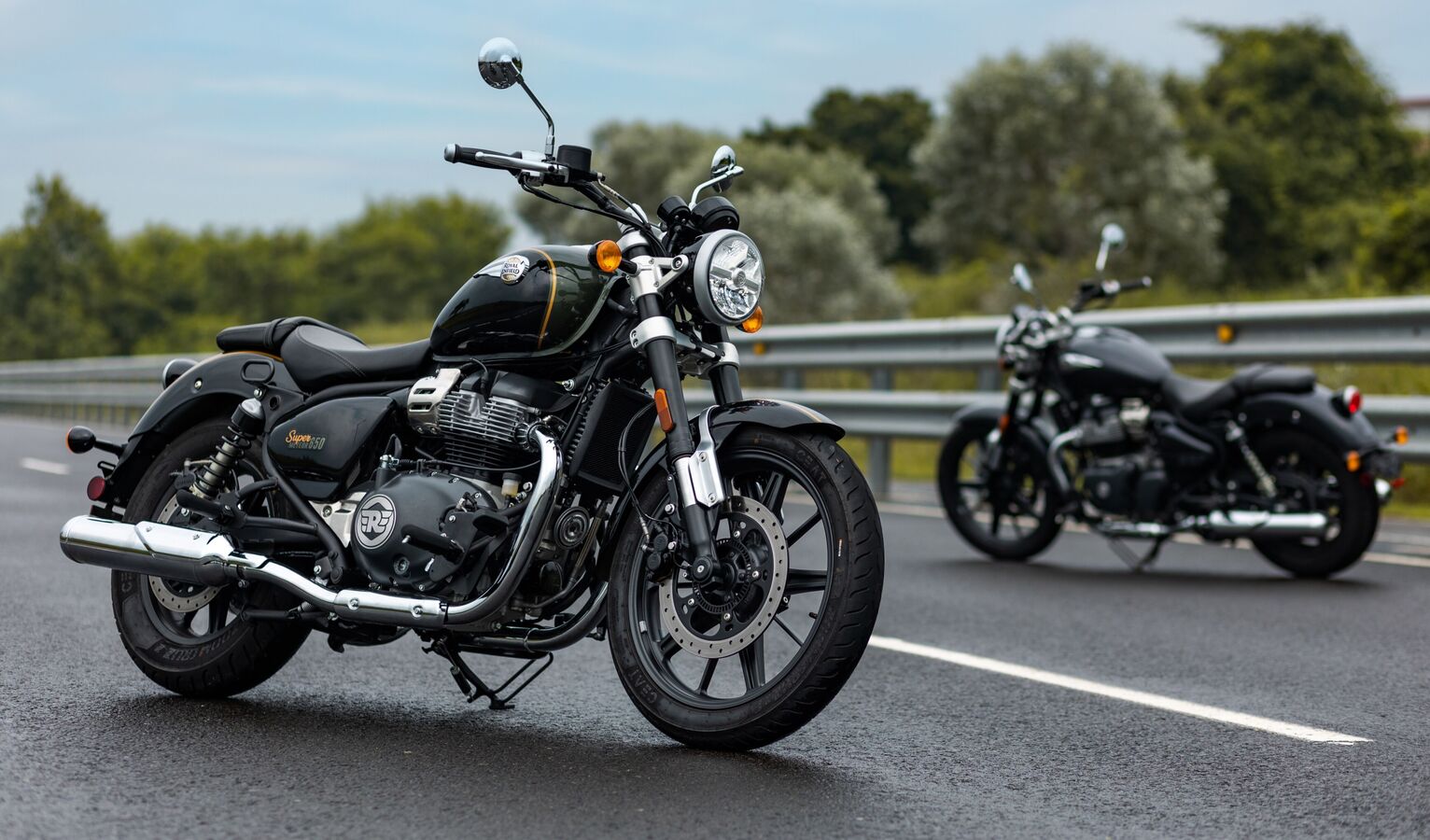EV space is on fire. Spoke to an incubator based in Pune and lots of work happening in that field. You already see a sizeable number of Tata Nexon EVs on the road. I hope in 3-4 years time, our import bill drastically comes down with the EVs being the norm.Mahindra today made the biggest play yet by an Indian carmaker in the EV space while announcing its electrification plan for the next decade. The company will launch two new EV sub-brands, XUV and BE, while also revealing five EV concepts which will launch between 2024 to 2026. These XUV branded EVs will come to market first starting with the XUV.e8. This SUV will launch in December 2024. Take a closer look at this SUV.
Thoughts everyone?
@Jackdaws @Peace Lover @Rajaraja Chola @Milspec @Paro et al. ?
Latest Thread
You are using an out of date browser. It may not display this or other websites correctly.
You should upgrade or use an alternative browser.
You should upgrade or use an alternative browser.
Mahindra today made the biggest play yet by an Indian carmaker in the EV space while announcing its electrification plan for the next decade. The company will launch two new EV sub-brands, XUV and BE, while also revealing five EV concepts which will launch between 2024 to 2026. These XUV branded EVs will come to market first starting with the XUV.e8. This SUV will launch in December 2024. Take a closer look at this SUV.
Thoughts everyone?
@Jackdaws @Peace Lover @Rajaraja Chola @Milspec @Paro et al. ?
Article on the subject I found:
Mahindra Unveils Five New Electric SUV Concepts Based On The Brand New INGLO Platform
Mahindra Unveils Five New Electric SUV Concepts Based On The Brand New INGLO Platform
Mahindra is gearing up to dominate the battery electric vehicle (BEV) space with the launch of its brand new Indian Global (INGLO) platform which will form the base for five new electric SUVs and future electric models along with two electric brands - XUV and BE.
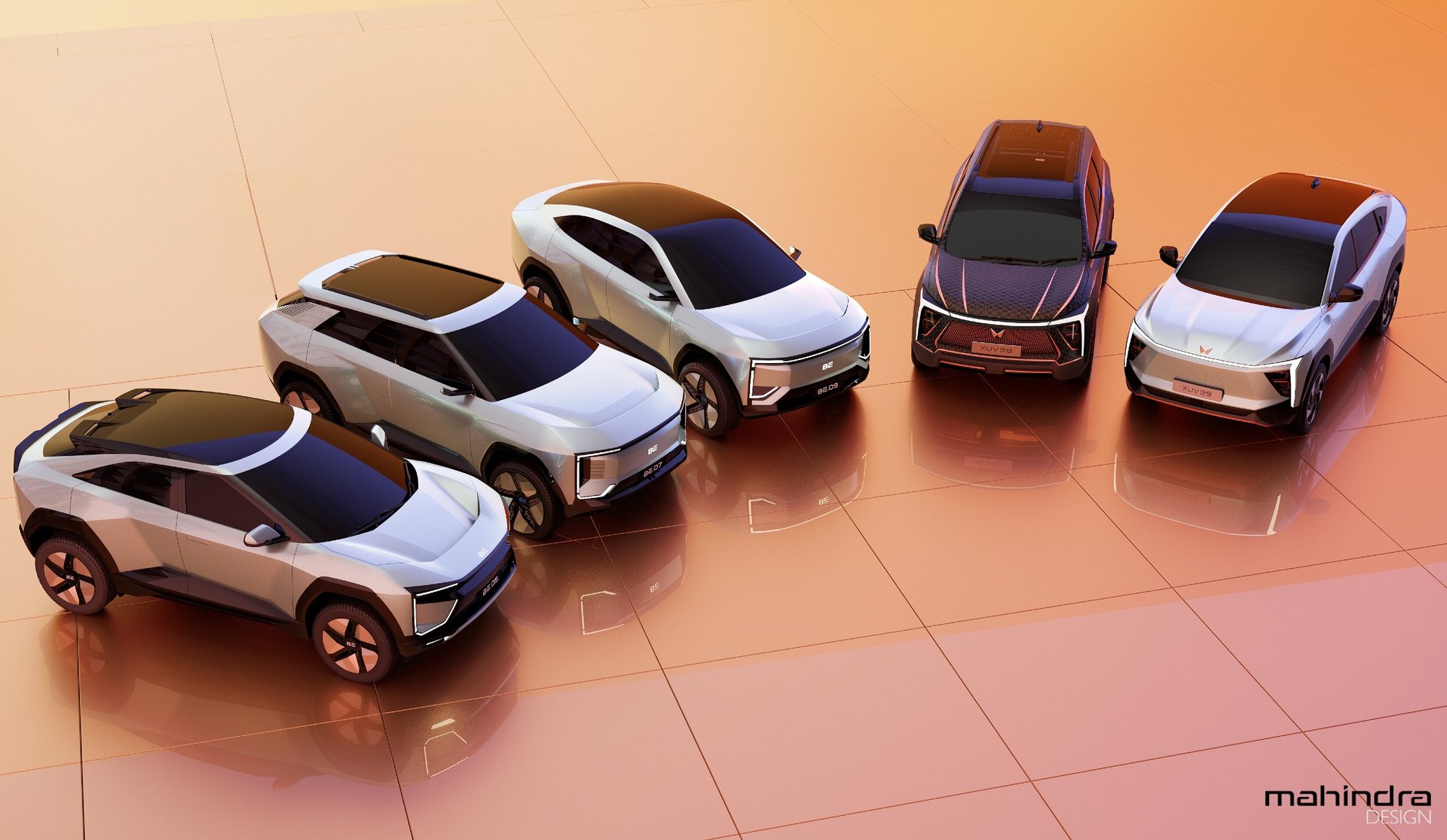

Mahindra & Mahindra is one of the most prominent SUV makers in our market and now it is gearing up to dominate the battery electric vehicle (BEV) space with the launch of its brand new Indian Global (INGLO) platform. The brand new platform will form the base for five new electric SUVs and the company's future electric models along with two electric brands - XUV and BE. The five new BEV concepts that break cover today are XUV.e8, XUV.e9, BE.05, BE.07 and BE.09 and all these models will be underpinned by the new INGLO platform. The first of these five electric SUVs will hit the road in 2024, followed by three more launches by between 2024 and 2026.
Mahindra is claiming that the new INGLO platform will be one of the lightest skateboard platforms that can equip high energy density batteries and uses Volkswagen's Modular Electric Drive Matrix Battery (MEB) platform components. The XUV brand will host a range of products boasting a sophisticated futuristic design, pulsating performance and dynamic innovation. On the other hand, the BE brand will have a bolder design language giving its models a comparatively more robust and butch demeanour. Here are the SUVs Mahindra has unveiled today.
Mahindra XUV.e8
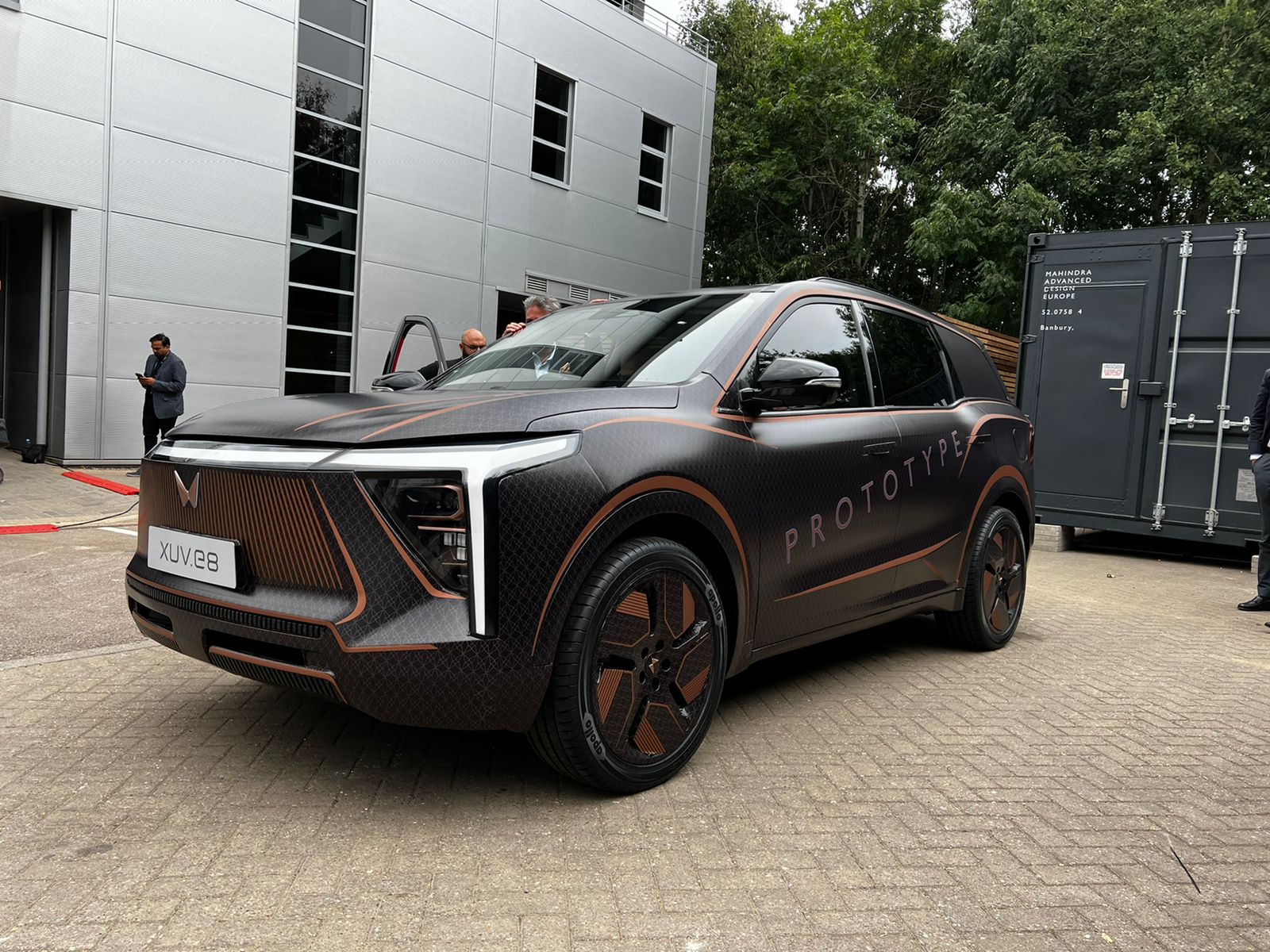
The first SUV to be launched will be the Mahindra XUV.e8 which will hit the road in December 2024. The SUV will be 4740 mm long, 1900 mm wide and 1760 mm tall, having a wheelbase of 2762 mm. It will take design inspiration from Mahindra's XUV700 flagship internal-combustion SUV (pic below) and will come with an all-wheel-drive (AWD) system.
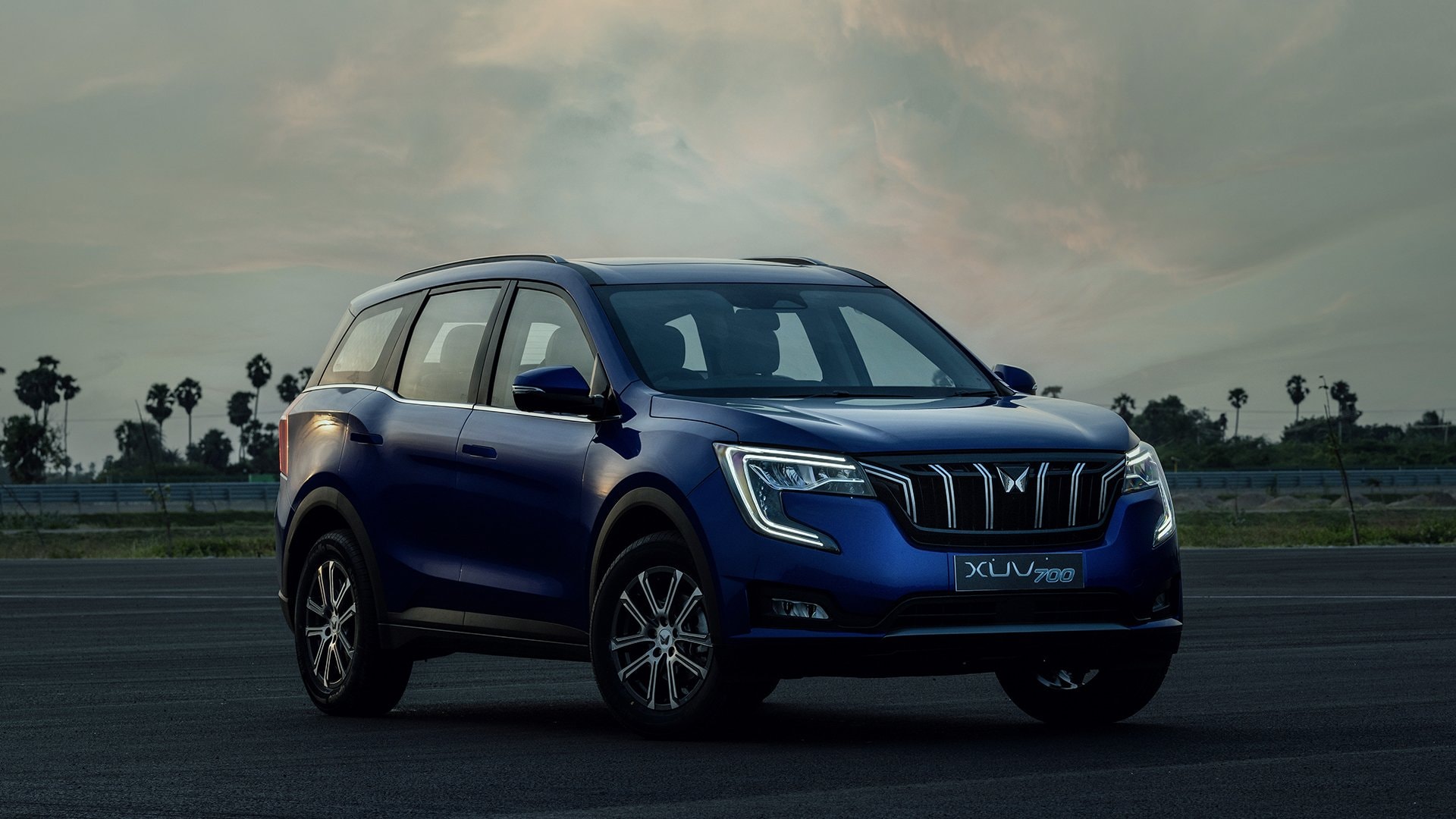
Mahindra XUV.e9
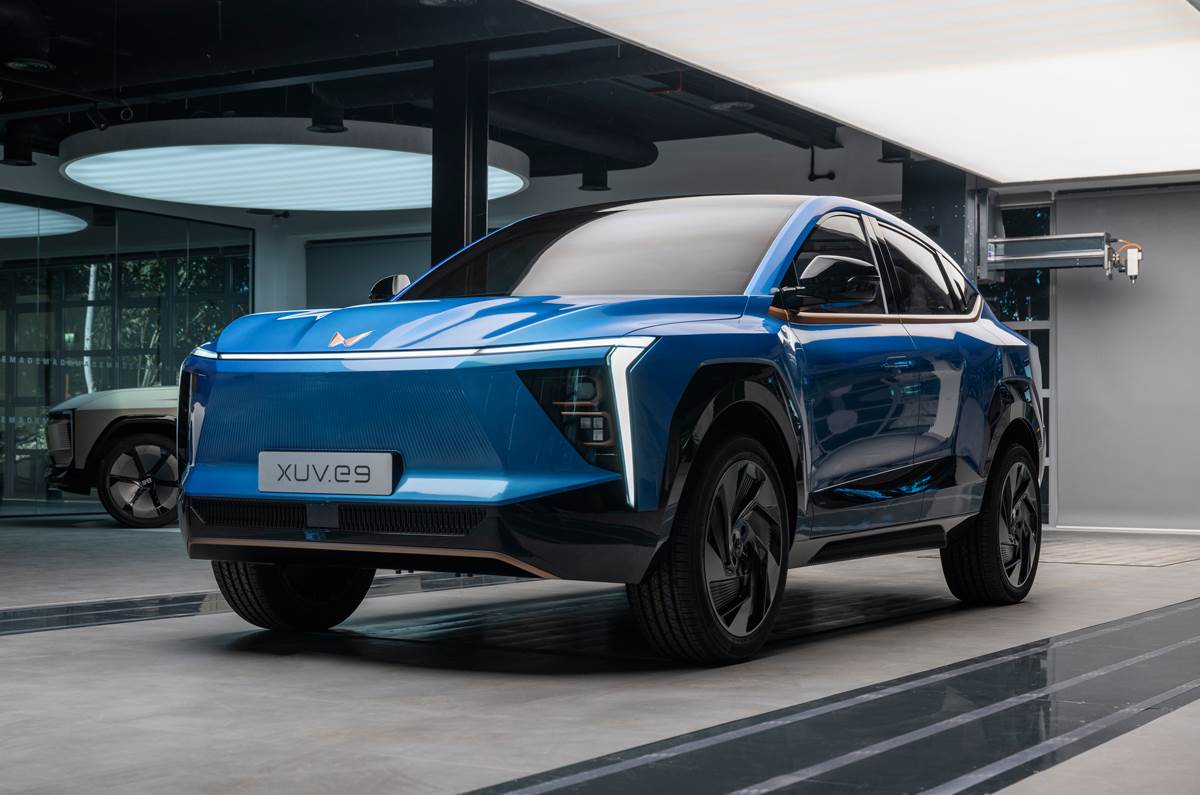
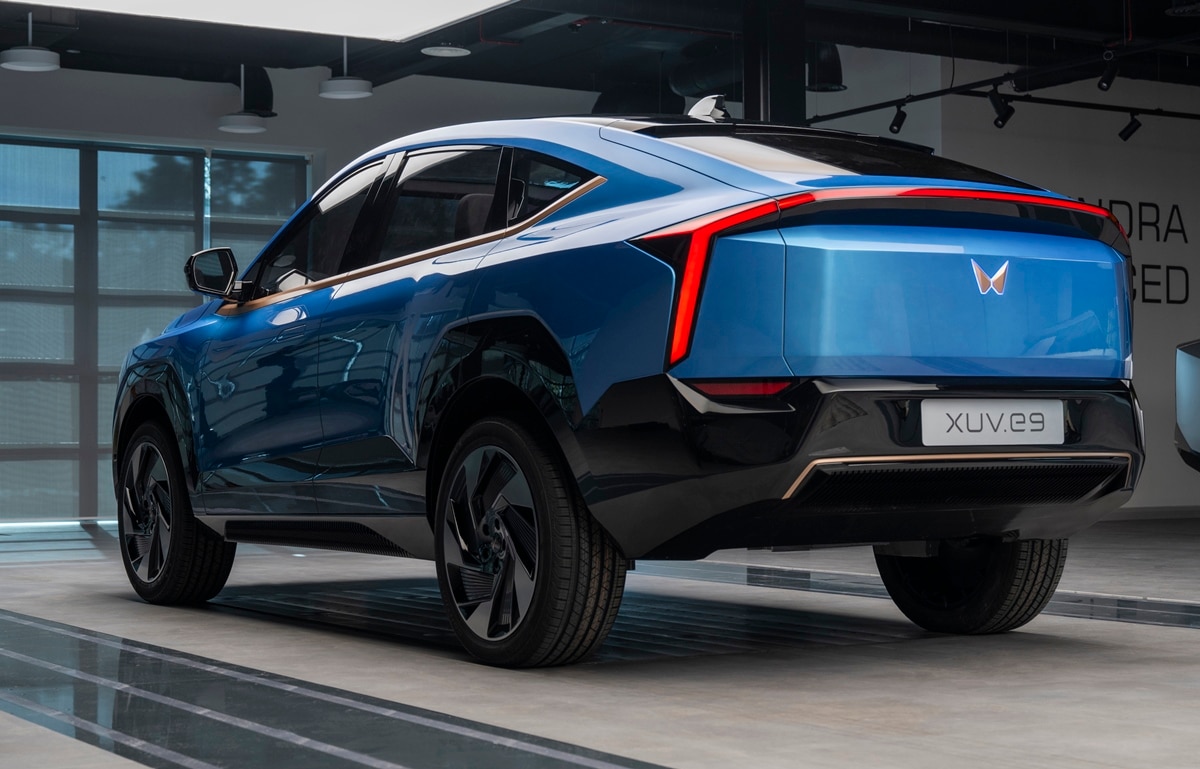
Then comes the Mahindra XUV.e9 which will go on sale in 2025 and will be 4790 mm long, 1905 mm wide and 1690 mm tall, offering a wheelbase of 2775 mm. The SUV will boast its coupe silhouette with a tapering roofline, similar to what we saw on the Mahindra XUV500 Aero concept at the Auto Expo 2016, but will share design cues with the XUV700 up to its B-Pillar. Even this SUV will be offered in both RWD and AWD versions.
Mahindra BE.05
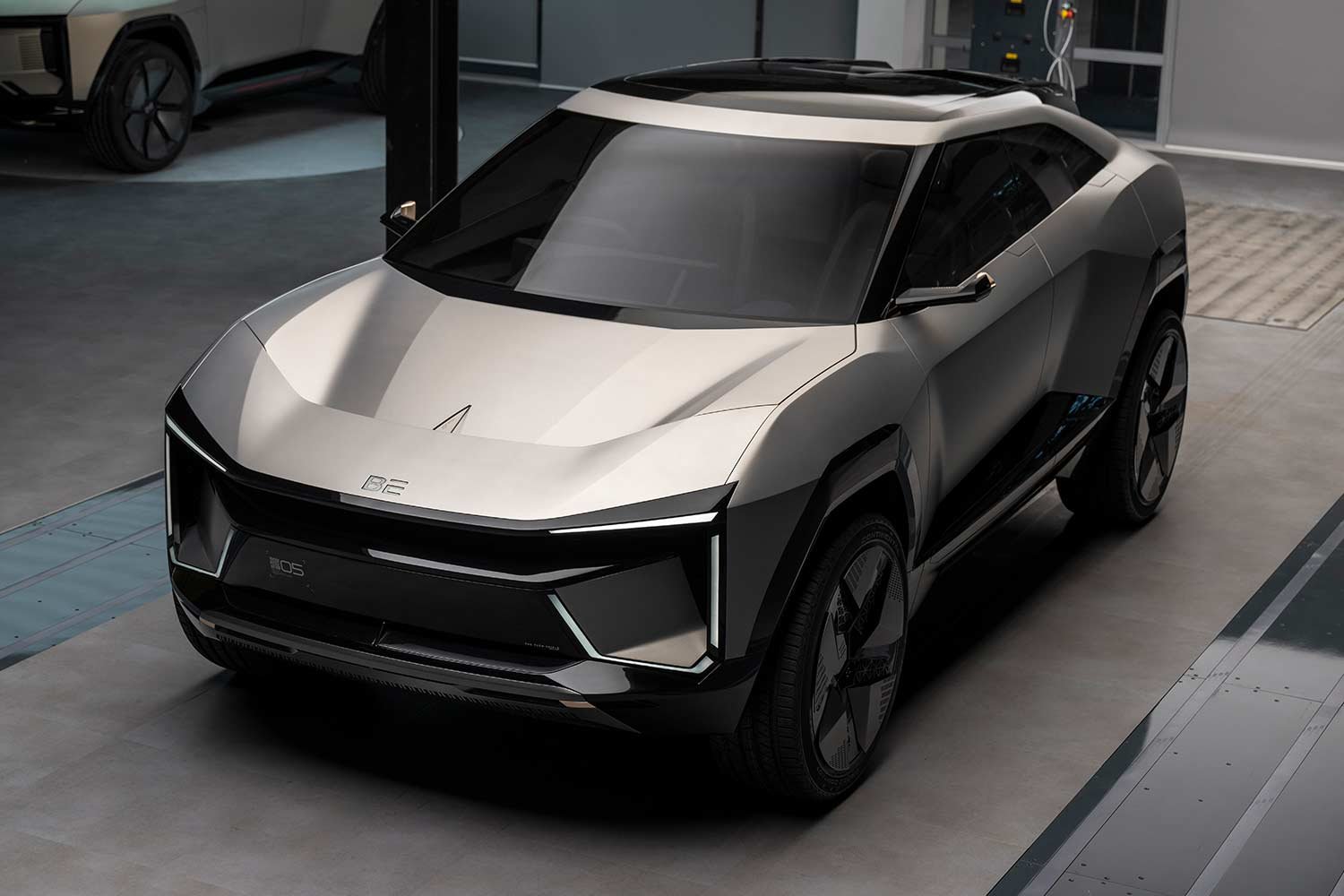



The BE05 will be 4370 m in length, 1900 m in width and 1635 m in height, having an wheelbase of 2775 m. Mahindra says that it will be a Sports Electric Vehicle (SEV) and will have a racing inspired bold design complemented seamlessly by multi-sensory experiences. The EV will go on sale in 2025.
Mahindra BE.07
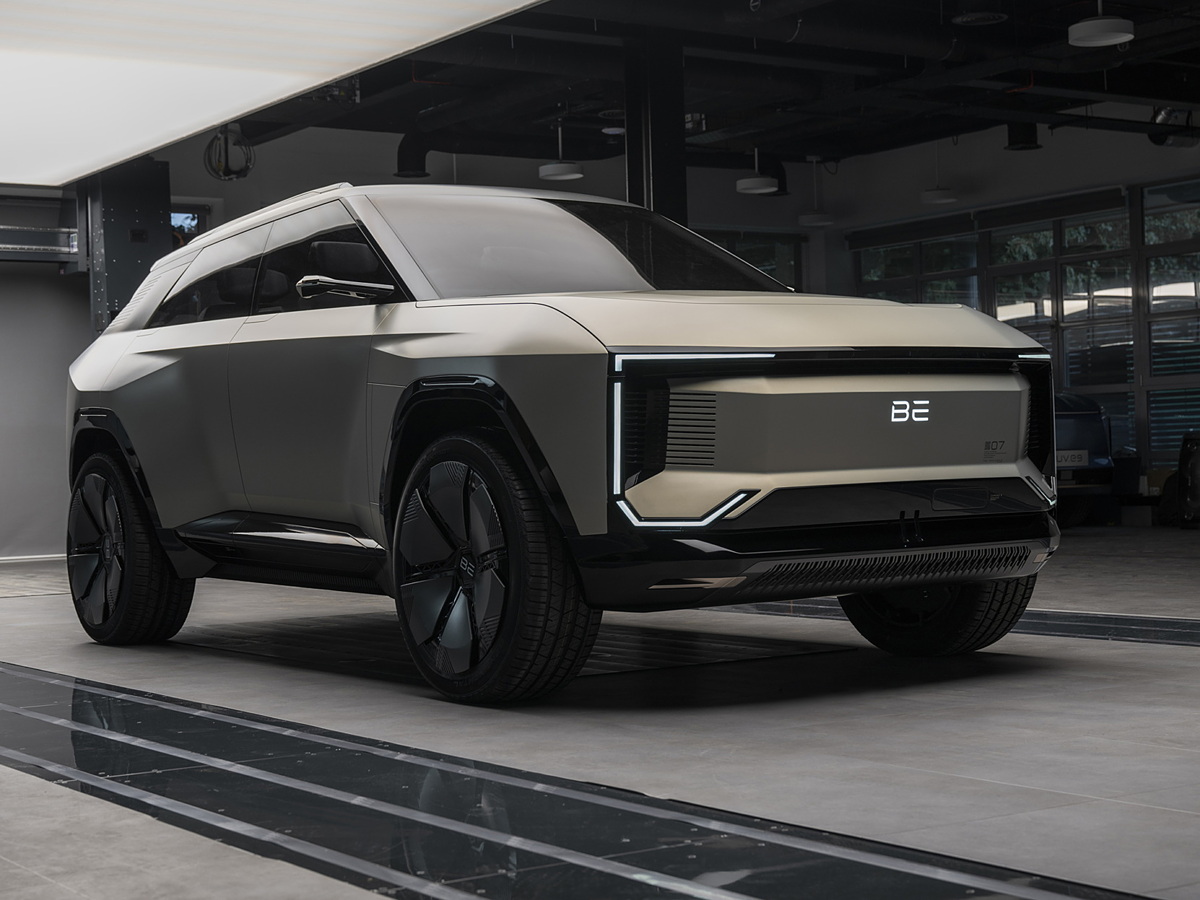
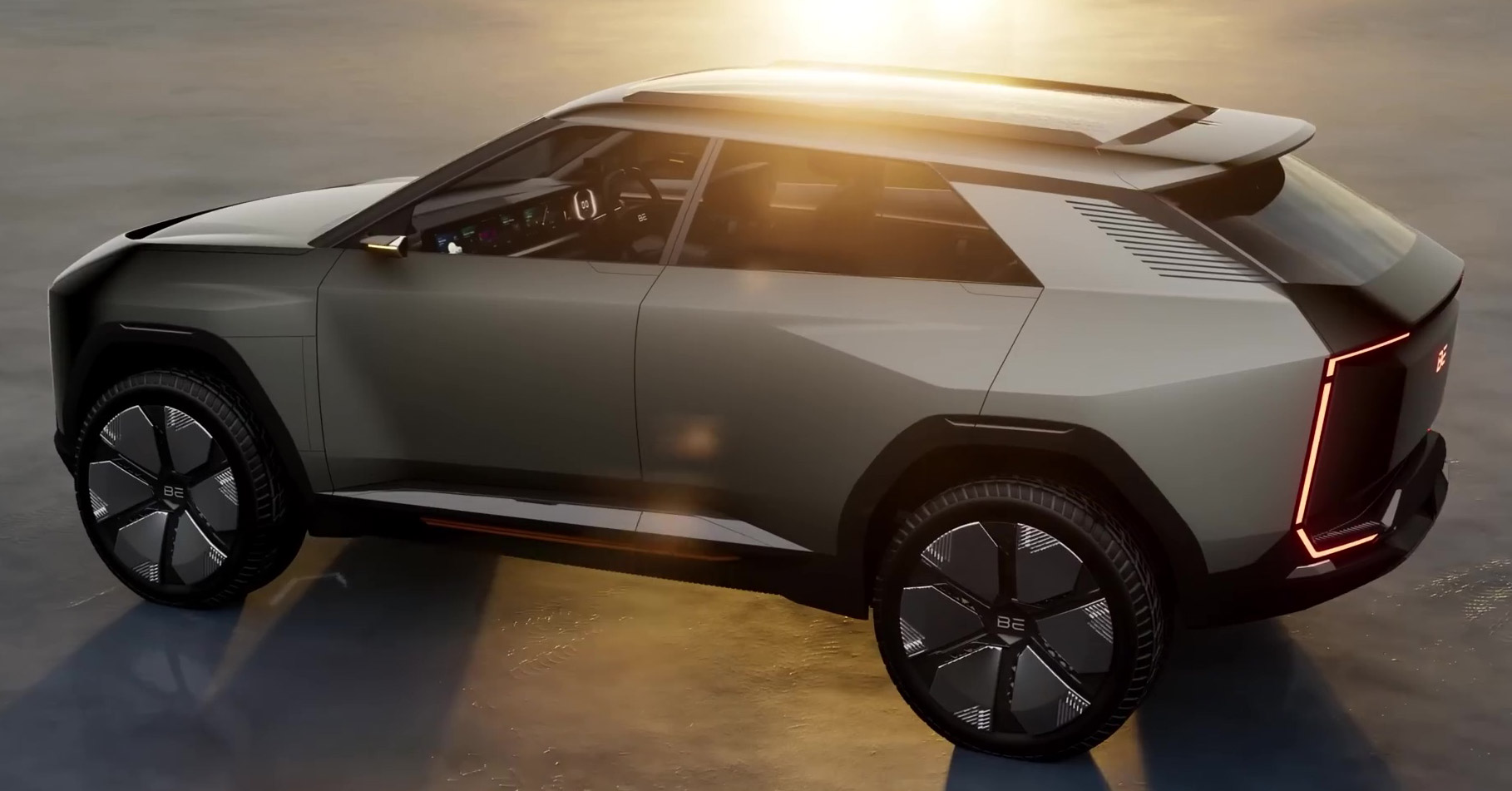


The BE.07 is scheduled to be launched in 2026 and will be 4565 m in length, 1900 m in width and 1660 m in height, and will have the same wheelbase of 2775 m as the BE.05. This will be a three-row family SUV which will be designed for long distance travel and will be versatile enough for city usage.
Mahindra BE.09
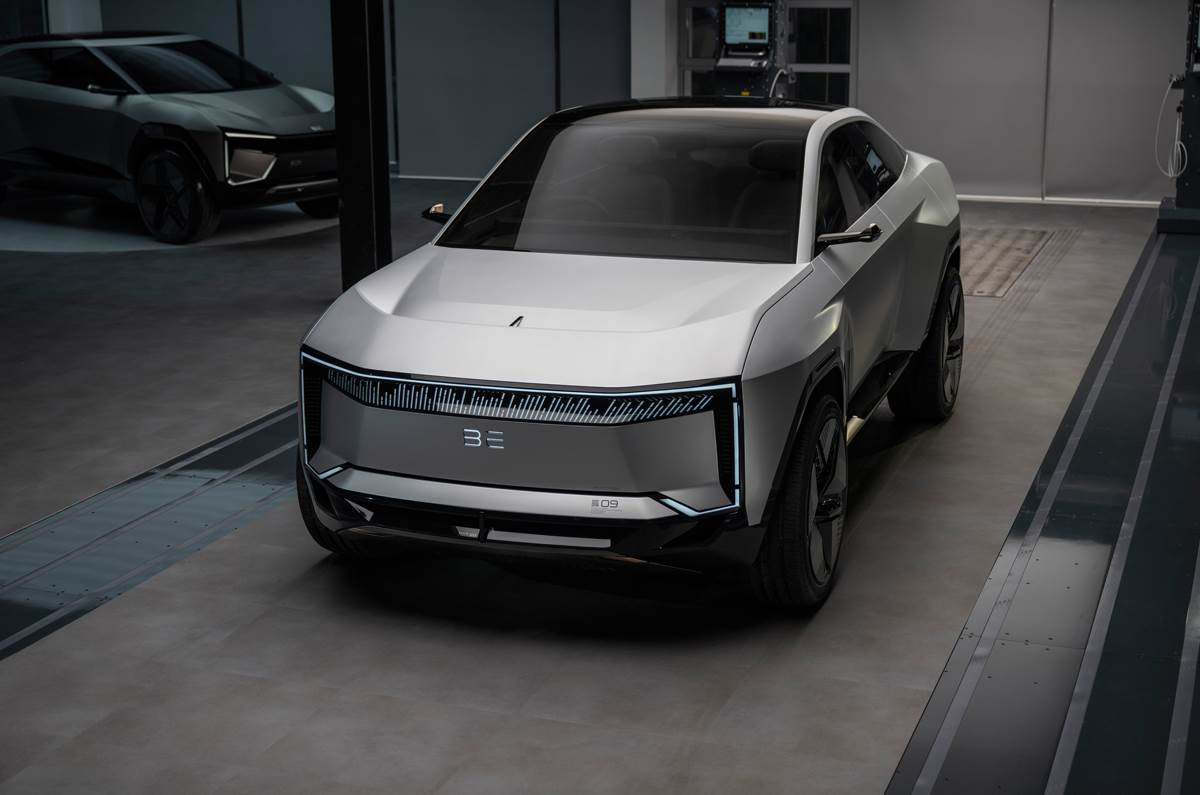
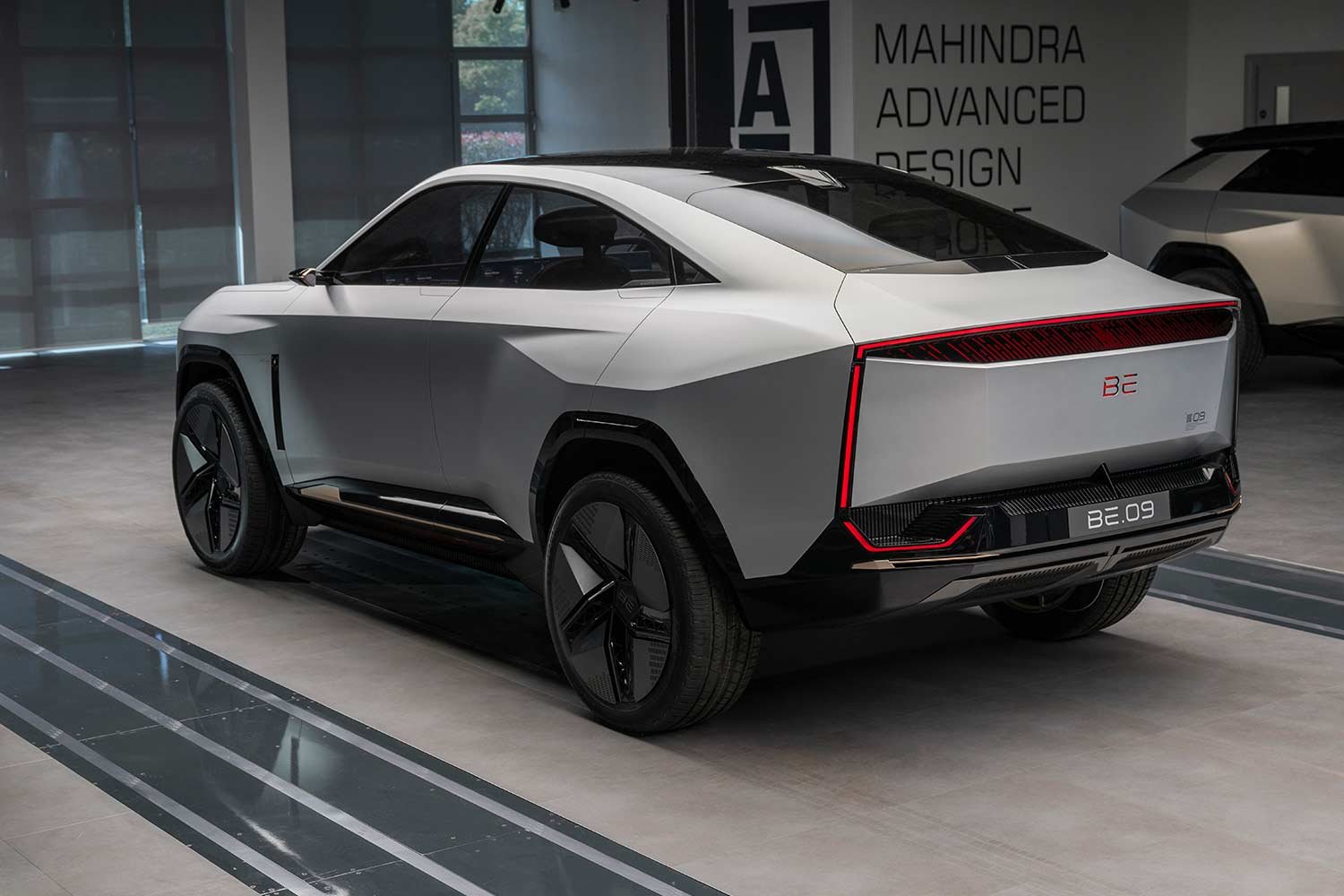


The launch and technical details of the BE.09 is still to be known, but the company says that it will be a "head turning" grand tourer SUV with a chiseled design, dynamic roof and solid stance.
The INGLO platform also delivers a multi-sensorial driving experience with a futuristic, augmented reality-enabled heads-up display, edge-to-edge screen, 5G network capability and Over-The-Air updates that play a crucial role in today's connected age. It also offers significant reduction in underbody weight and will follow a common battery pack design with lean modules and standardised cell-to-pack technology using two different cutting-edge cell architectures - Blade and Prismatic. These models will be offered with options ranging from 60-80 kWhr battery capacity, sufficient for 175 kW fast-charge and charging up to 80 per cent in less than 30 minutes. Moreover, it will be offered with both rear-wheel drive (RWD) and all-wheel drive (AWD) options, belting out 170 kW to 210 kW and a whopping 250 kW to 290 kW, respectively. The models will do the 0-100 kmph sprint in between 5 and 6 seconds.
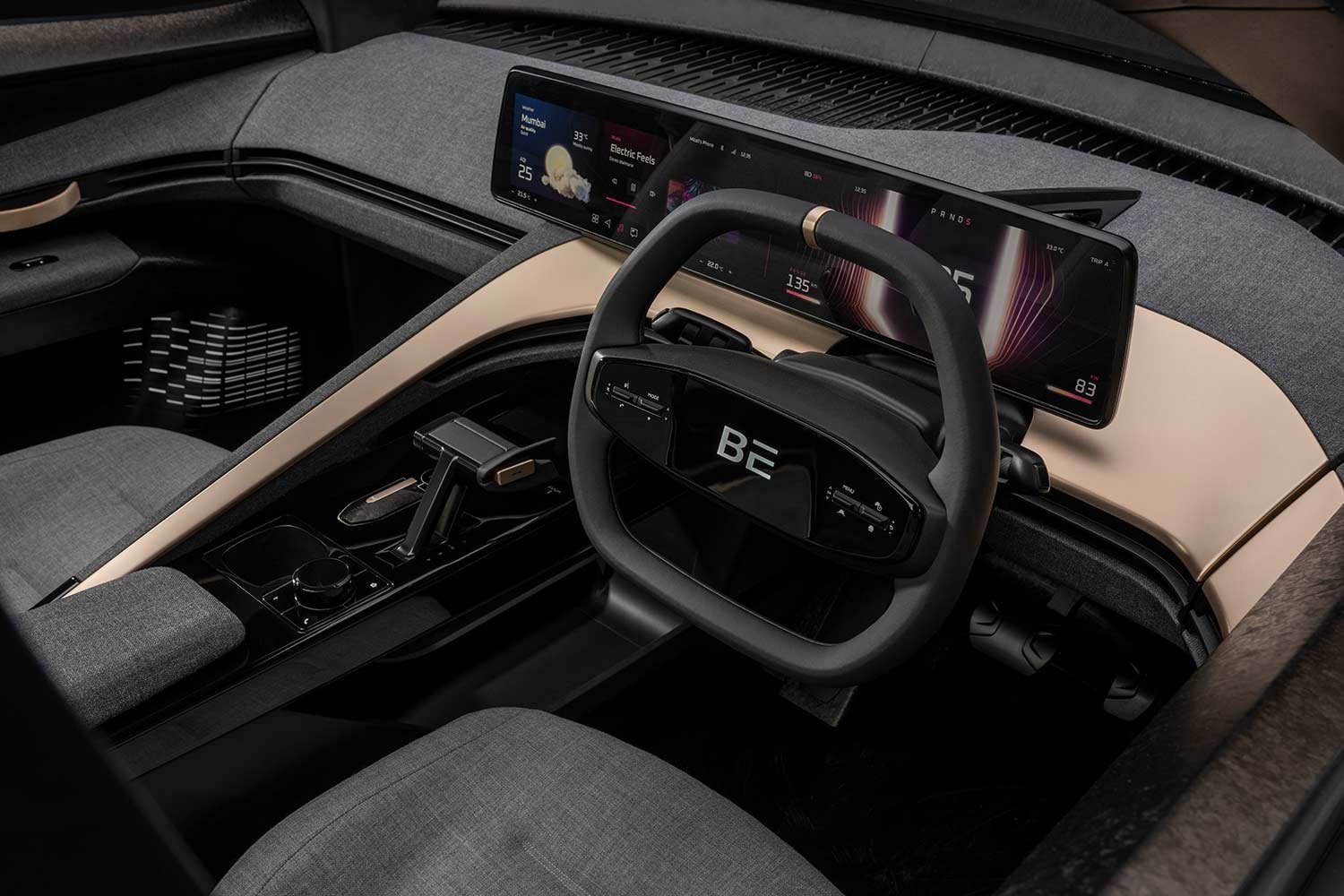
Now coming to the range, enhanced aerodynamics, reduced rolling resistance with 5.5 RRC tires and sophisticated zero-drag wheel bearings, high-efficiency cooling & HVAC system with minimal power consumption a will contribute to the overall efficiency and a semi-active suspension system will not only provide excellent ride comfort but also enhanced handling and an immersive sporty drive experience. Moreover, these vehicles will also feature brake-by-wire technology.
Carrying forward its legacy of designing some of the safest cars on the Indian roads, Mahindra will design these electric SUVs to meet the highest vehicle safety norms and utmost safety for batteries such as GNCAP and not just limited to regulatory compliance. All the e-SUVs will come with a structural cage around the passenger cabin specially designed for reduced passenger injury.
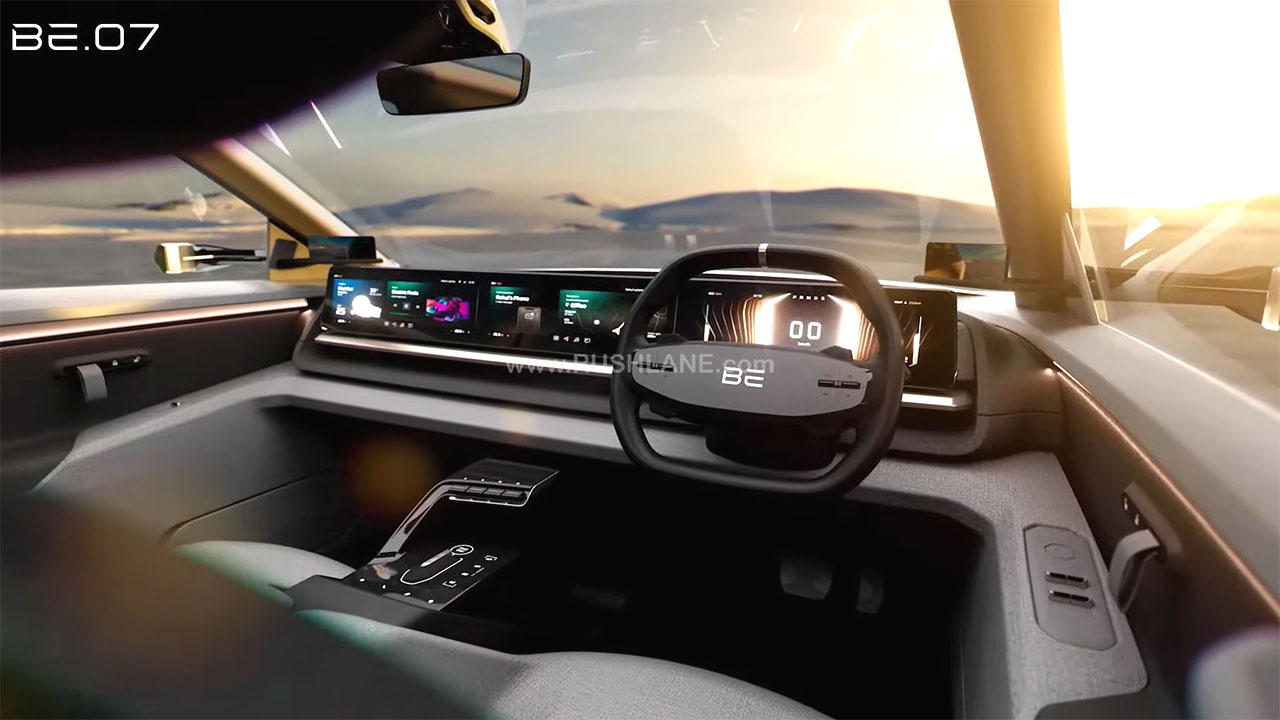
The frontal design of the Body-In-White is enhanced with three load paths and a multi-piece dash panel with reinforcement and superior battery protection ensured by ultra-high strength boron steel. Moreover, with 5 Radars-1 Vision ADAS architecture, INGLO platform is ready for up to L2+ autonomy.
In terms of practicality, Slim cockpits and a flat floor create generous and flexible interiors, giving control of seat configurability and space versatility such as frunk and trunk storage. The car can be turned into a portable power bank, allowing you to charge your phone or laptop, or take any household appliance on the road with you. It will also get latest systems of chips from global semiconductor vendors for up-to-date tech nodes of semiconductor wafer processes: 200K DMIPS computing power via Dual Octa-core processor and offering 1920 x 720 pixels HD resolution.
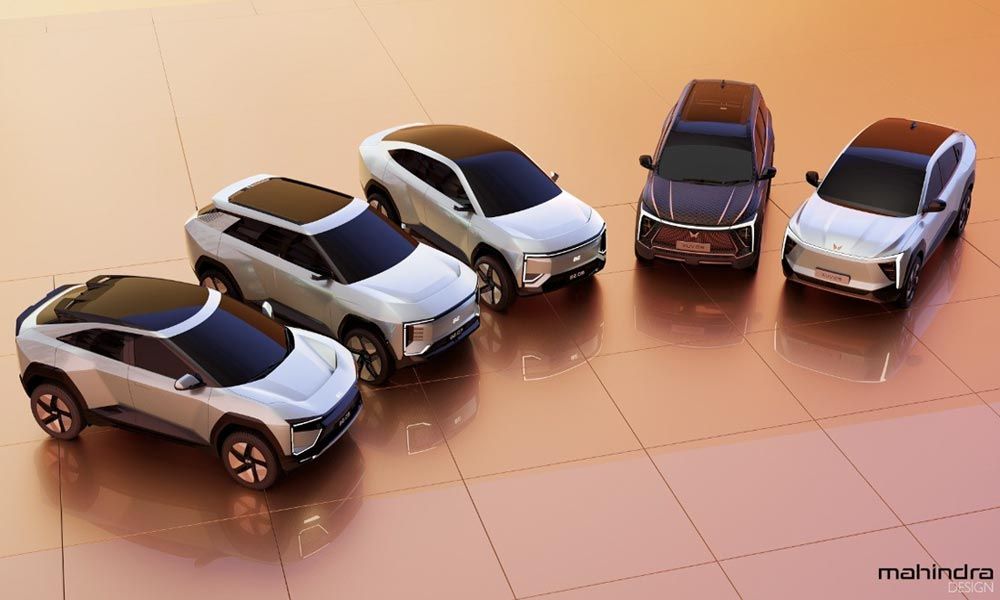
Mahindra Unveils Five New Electric SUV Concepts Based On The Brand New INGLO Platform
Mahindra is gearing up to dominate the battery electric vehicle (BEV) space with the launch of its brand new Indian Global (INGLO) platform which will form the base for five new electric SUVs and future electric models along with two electric brands- XUV and BE.
EV game is still out there for anyone to turn. Mahindra will need a lot more substantial investment if it really wants to compete with intl players.Mahindra today made the biggest play yet by an Indian carmaker in the EV space while announcing its electrification plan for the next decade. The company will launch two new EV sub-brands, XUV and BE, while also revealing five EV concepts which will launch between 2024 to 2026. These XUV branded EVs will come to market first starting with the XUV.e8. This SUV will launch in December 2024. Take a closer look at this SUV.
Thoughts everyone?
@Jackdaws @Peace Lover @Rajaraja Chola @Milspec @Paro et al. ?
Any idea what is the % of value addition done in India relative to the final price?

Auto bosses head to India to charge up electric vehicle game plan
ET has learnt that the entire Skoda Auto board led by CEO Klaus Zellmer is set to visit the country in October. Martin Daum, the chairman of Daimler Truck AG, and Karl Deppen, head of Daimler Truck Asia, will be visiting Chennai to celebrate 10 years of Bharat Benz in the country. Nissan Motor...
Tata Tiago EV Is A $10,000 Electric Car For India
The Tata Tiago EV is an inexpensive 5-door electric hatchback designed specifically for driving conditions in India.
Tata Tiago EV Is A $10,000 Electric Car For India - CleanTechnica
The Tata Tiago EV is an inexpensive 5 door electric hatchback designed specifically for driving conditions in India.
 cleantechnica.com
cleantechnica.com
Tata Motors, one of India’s largest vehicle manufacturers, has announced a new made-in-India electric car called the Tiago EV, a 5-door hatchback based on the the company’s Ziptron electric car platform, which is optimized for driving conditions in India. The Tiago EV starts at around $10,000 with a 19.2 kWh battery and 3.2 kW charging. The company says it has a range of 250 kilometers. For around $14,500, drivers can upgrade to a 24 kWh battery version with 315 kilometers of range and a 7.2 kW charger.
Shailesh Chandra, managing director of Tata’s passenger car division, waxed eloquent in a company press release.
“Having pioneered the EV market in India, we have successfully led its growth and penetration over the last couple of years. We believe ‘now’ is the right time to fast forward the ongoing revolution towards the future of mobility by introducing vehicles that will encourage rapid adoption of EVs.
“With the launch of the Tiago EV, India’s first electric hatchback, the nation can take a giant leap forward in the quest for safe, clean and green mobility. It is an ideal fun hatch which offers premium safety and technology features, eco-friendly footprint, spirited performance, all made even more desirable with the added advantage of a low cost of ownership.
“It will be the first in its segment to offer best-in-class connected features as standard across all trims, that are usually offered in more premium cars. It comes with two options of battery packs and four different charging solutions, enabling customers to choose the combination that best serves their mobility needs.
“Furthermore, with an aim to make our EVs more accessible, with this launch we are entering 80 new cities, expanding our network to more than 165 cities. We are confident that this move will help more and more customers embrace EVs as their preferred mode for personal mobility. We remain focused to play our role in fulfilling India’s commitment towards reducing carbon footprint from auto emissions and will offer more choice to customers with a portfolio of 10 EVs by 2026.”

Image courtesy of Tata Motors
Motor1 reports the Tata Tiago EV uses a 55 kW (74 hp) permanent magnet synchronous electric motor powering the front wheels. It generates 114 Newton-meters (84 pound-feet) of instant torque. Tata says the new car scoots to 60 km/h in less than 6 seconds. Sales begin October 10.
“Scoots” may be a bit of an overstatement. The Tiago EV is no autocross machine. What it is, is a competent electric car specifically tailored to the needs and expectations of its intended customers. There is no shame in that. Not everyone needs an 8-passenger, 7,000-pound mini-shipping container on wheels. Sometimes adequate is good enough. The Tata Tiago EV is a competent car. Isn’t that enough?
I read yesterday that the average price of a new electric car in America is $67,000 — about $20,000 more than that average price of a new conventional car. That’s a problem. The EV revolution we so ardently wish for is not going to happen, at least not in North America, so long as the price of an electric car remains out of reach for many customers.

Image courtesy of Tata Motors
Chevrolet seems to be the only US manufacturer interested in giving Americans affordable electric cars with the Chevy Bolt and upcoming Chevy Equinox EV. Elon Musk can’t be bothered, while Ford and Hyundai/Kia seem to have no interest in pursuing the goal of affordable electric cars either.
It’s little wonder EV sales in America are hovering around 5% of the new car market. Would something like the Tata Tiago EV appeal to US drivers? We’ll never know. Tata doesn’t sell its cars in North America and has no plans to do so.

Cummins and Tata Motors ink MoU to develop hydrogen-powered CVs | Autocar Professional
The Cummins B6.7H hydrogen engine with up to 290 hp (216 kW) output and 1200 Nm peak torque is an all-new engine platform featuring cutting-edge technology to enhance power density, reduce friction losses and improve thermal efficiency.
India surpasses Japan to become world's third-largest auto market: Report
India's sales of new vehicles came in at least 4.25 million units, based on preliminary results, topping the 4.2 million sold in Japan, according to a report by Nikkei Asia
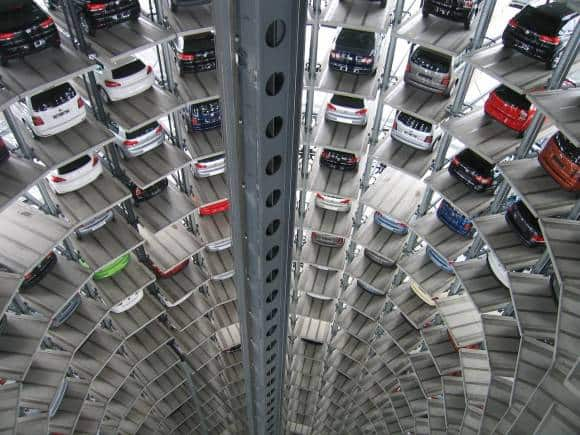
With 4.25 million new vehicles sold, India outpaces Japan as world's third-largest auto market
India's sales of new vehicles came in at least 4.25 million units, based on preliminary results, topping the 4.2 million sold in Japan, according to a report by Nikkei Asia
++++
Mahindra XUV400 Electric Sets New Record – 751 Kms, 24 Hrs, Sub 0 Temp
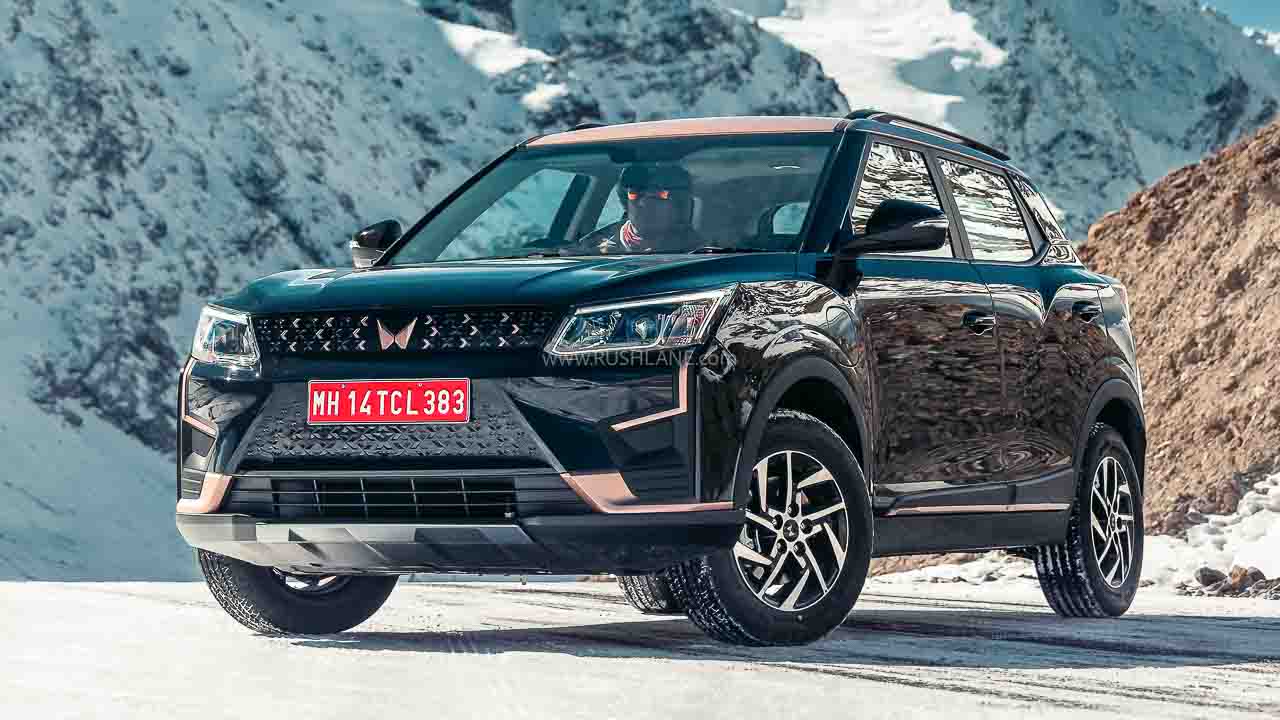
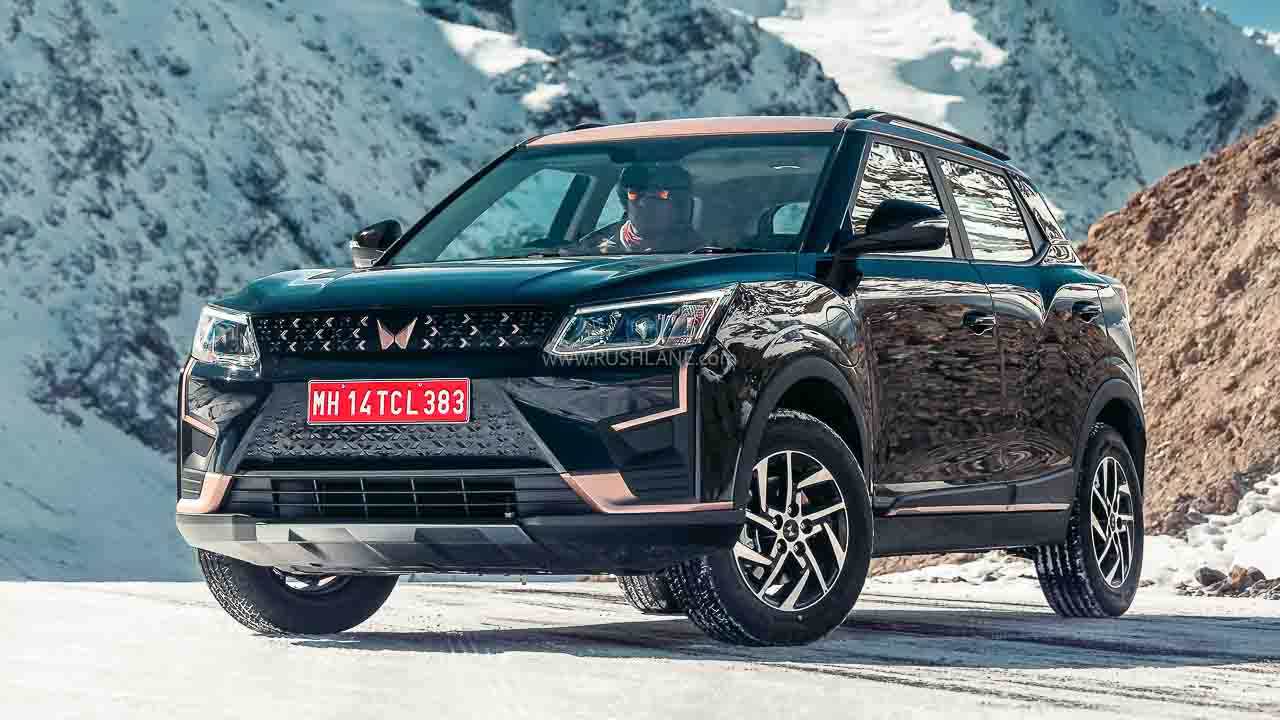
Mahindra XUV400 Electric Sets New Record - 751 Kms, 24 Hrs, Sub 0 Temp
Mahindra XUV400 has certified range of 456 km, can reach top speed of 150 kmph and achieve 0-100 in 8.3 seconds
Domestic passenger vehicle sales jump by 26.71% in FY23 to 3.889 million
Highest ever passenger vehicle sales in a financial year

Domestic passenger vehicle sales jump by 26.71% in FY23 to 3.889 million
Highest ever passenger vehicle sales in a financial year
Skoda just discontinued the Octavia. The Superb is next on the chopping block. Basically the Indian market has no mid size or full size sedan now under the 50 lac bracket. Jetta, Octavia, Passat, Civic, Accord, Corolla, Camry - all gone.
Skoda just discontinued the Octavia. The Superb is next on the chopping block. Basically the Indian market has no mid size or full size sedan now under the 50 lac bracket. Jetta, Octavia, Passat, Civic, Accord, Corolla, Camry - all gone.
Making full room for more EV foray here?
Ashok Leyland, one of India's (and the world's) largest commercial vehicle makers, is going full speed ahead with Hydrogen IC & Hydrogen Fuel-Cell solutions for their future fleet of truck offerings:
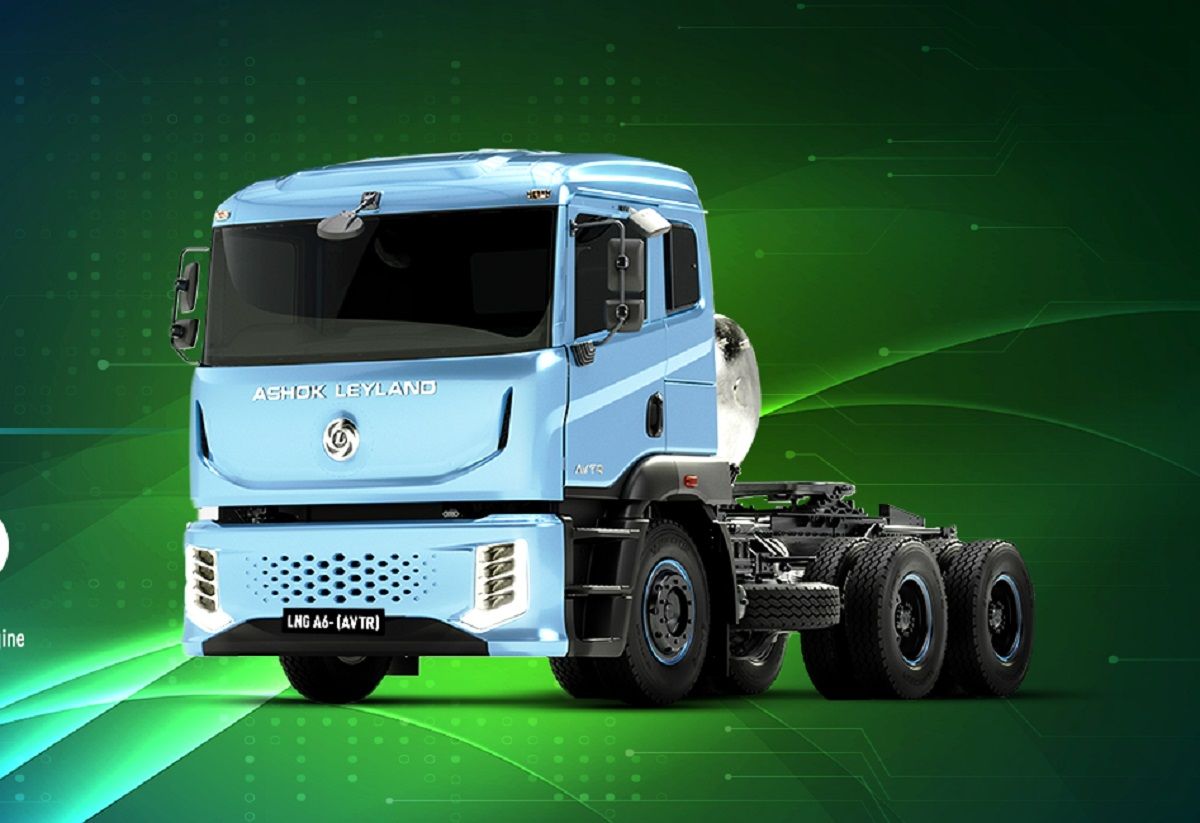
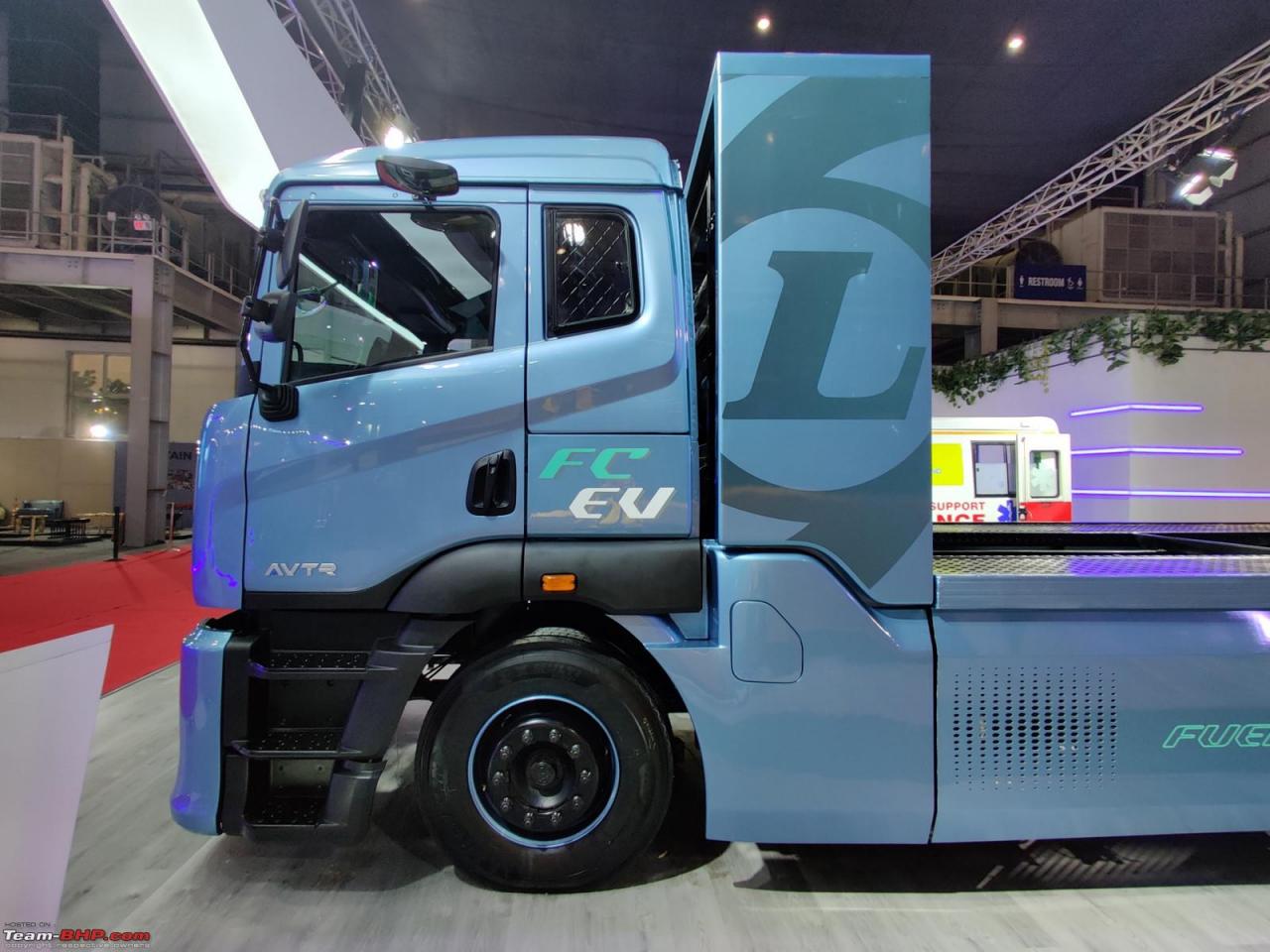
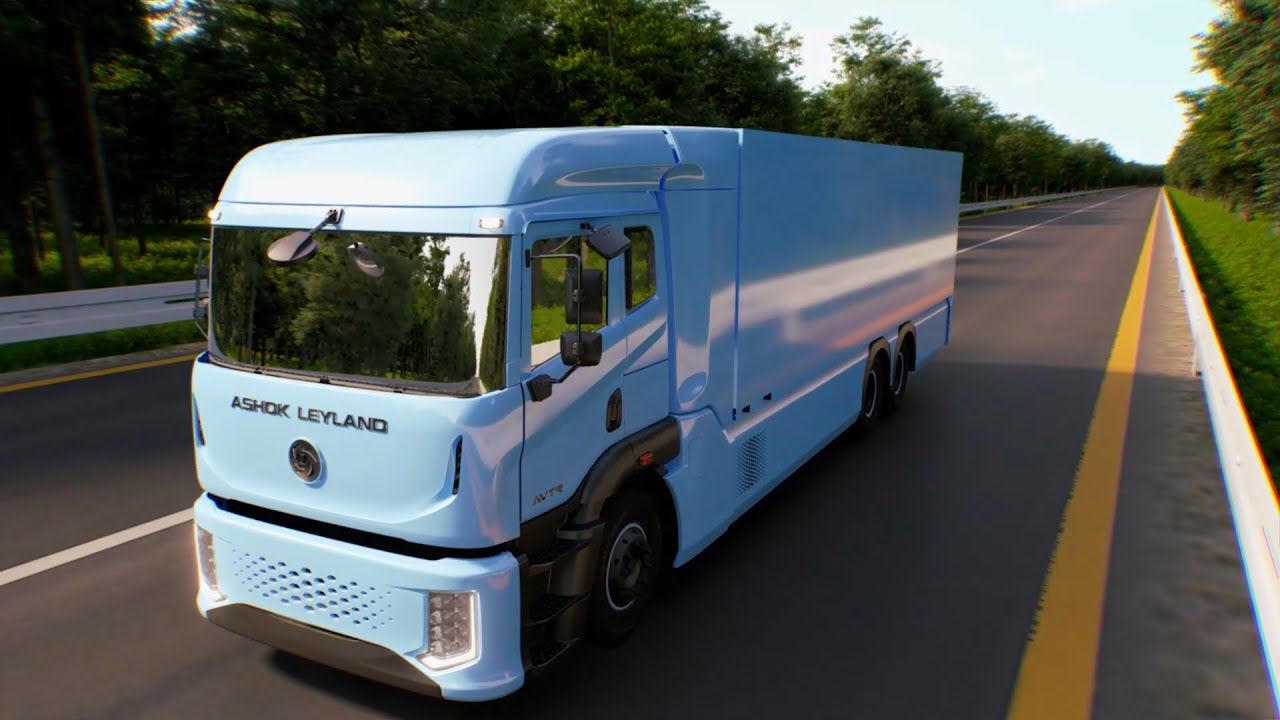



It's not just India but the demand for sedans reduced significantly all over with new car buyers mostly opting for SUVs or CrossoversSkoda just discontinued the Octavia. The Superb is next on the chopping block. Basically the Indian market has no mid size or full size sedan now under the 50 lac bracket. Jetta, Octavia, Passat, Civic, Accord, Corolla, Camry - all gone.
Companies like Ford, GM etc are completely discontinuing their sedan lineup
Right now that segment is dead, ev or not.Making full room for more EV foray here?
Right now that segment is dead, ev or not.
I mean more from the capacity and pricepoint trend here (i.e what would one buy with X amount of dollars in pocket, and switch of production capacity re-orienting to this).
Its taking shape globally in general as Zapper pointed out too.

India becomes destination for auto OEMs to secure their digital content needs
Indian engineering services providers have been developing automotive talent both in house and in collaboration with the academia. With Indian OEMs and startups starting and scaling up EV programmes, the requirement and sources of automotive talent have gone up.
As the software content in vehicles is growing, with systems like smart cockpits becoming an integral part of the auto ecosystem, India has become the go-to place to source digital engineering and talent. With its combination of readily available skilled engineers and ER&D (engineering research and development) hubs that offer low-cost solutions, India has become the destination for auto OEMs or original equipment manufacturers to secure their digital content needs, according to a recent JP Morgan Equity Research report.
The demand has been so high that last year, L&T Technology Services (LTTS), which provides engineering research and development services, set up a delivery centre in Krakow, Poland, to meet the requirements of a leading US-based auto OEM. The Krakow centre will be the hub of LTTS’ activities in Eastern Europe and could help provide more value to its global customers. Over the past three years, LTTS has spent $9-10 million to develop R&D infrastructure for its EACV (electric, autonomous and connected vehicles) practices alone.
“We have an EV lab at our Bengaluru facility to test solutions faster, and an electrification and prototyping centre for next-gen solutions in Peoria in Illinois, US,” says Amit Chadha, CEO, LTTS.
The urgency among auto OEMs to move towards EACV is pushing them to work with services providers to hasten product development cycles and eventual rollout in the market. Digital technology systems, including advanced driver assistance systems, and software defined vehicles (SDVs) are helping drive this journey, say experts.
ER&D services companies provide support to auto OEMs and tier-1 component suppliers in vehicle product design and development of electric motors, car infotainment systems and algorithms for autonomous driving.
“The savviest services providers which have a strong client base are investing in and chasing critical trends to drive opportunities for growth. India has moved to a leadership position in terms of being a go-to source for digital engineering and an established, trusted location,” says Frances Karamouzis, group chief of research, Gartner.
Leading services providers such as LTTS, KPIT Technologies, Tata Elxsi and Cyrient are betting big on EACV and investing in digital engineering, talent building and upskilling.
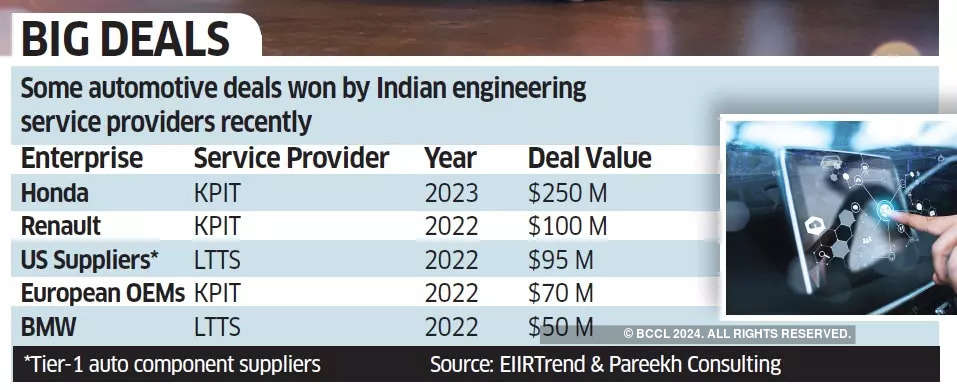
KPIT has started investing in all domains of automotive software. “OEMs need a strong partner for software just like they need one for semiconductors or cloud. This is now the focus of KPIT. Billions of dollars are being invested by vehicle makers that will determine their future business and technology roadmap,” says Kishor Patil, CEO & MD, KPIT Technologies, which has made acquisitions worth $150 million in the last few years in this area. KPIT, which offers embedded software and product engineering services to automotive companies, has developed multiple centres in North America, Europe and Asia.
“More than 80% of our work revolves around cutting-edge SDV programmes. We are playing a key role globally in six out of nine SDV programmes,” says Patil. KPIT has tied up with Renault and Honda as its software integration partners.
Auto enterprises are partnering with IT services providers for exploring new technology applications. Recently KPIT and ZF, the Germany-headquartered company that supplies systems for passenger cars and commercial vehicles, entered into a partnership to create solutions for automotive systems. Capgemini and Audi have launched a joint venture, XL2, which provides digital technology in the fields of SAP and cloud services.
Tata Elxsi has won multiple deals in the EACV space over the past two years and counts Jaguar Land Rover its biggest customer in this area. Its EBITDA margin in this vertical is 30%, which is significantly higher than its peers due to new product development work and high offshore mix, according to Auto ER&D Services Primer by JP Morgan Equity Research, released in April.
NO SLOWDOWN IN ER&D SPENDS
The uncertain macro conditions have not slowed down auto ER&D spends. One of the growth drivers is EACV, and services providers are winning multi-year deals in this space. This could lead to India’s share in ER&D offshoring rising to 33% by FY32 from 25% in FY22, according to the JP Morgan report. These tailwinds will benefit auto ER&D services companies.
“Automotive industry forms a good proportion of total engineering spend (20%), a high proportion of outsourced ER&D spend (30%) and an even higher proportion of ER&D large deals (40%),” says Pareekh Jain, CEO, EIIRTrend & Pareekh Consulting.
Recent projection by industry bodies indicate that the ER&D spend patterns will remain resolute in the face of potentially adverse macro headwinds –– growing at a 6% CAGR by 2025 to reach a total of $2 trillion.
The renewed focus on newage technologies has had a positive impact on ER&D offshoring, especially in high-potential regions like India. The Indian ER&D sector is projected to be worth over $63 billion by 2025, according to NASSCOM, and most of these services providers stands to benefit. LTTS aspires to hit $1.5 billion revenue in FY25.
DEMAND FOR TALENT
Services providers are attracting talent from multiple areas and upskilling them in different operating systems. KPIT Technologies, which added 3,800 employees to its workforce last fiscal, says it is bringing in people from banking, semiconductor and technology companies.
“We say the automotive industry is the coolest industry right now,” says Patil of KPIT Technologies.
Demand for digital engineering talent continues to outstrip supply. This is a key factor in driving offshoring, especially in developed economies. However, there is also a strong trend in favour of developing local talent to address the shortfall. Companies like LTTS are expanding their footprint across Poland, France, Canada and the US. “We have plans to add over 1,000 local engineering talent across global centres and in India. In the first quarter of FY24, we are likely to add around 500 engineers,” says Chadha of LTTS.
“The ebb and flow of talent supply and demand certainly impacts pricing of deals,” says Karamouzis at Gartner.
“India is in a sweet spot because in no other geography can enterprises get digital talent at scale and cost-effective price points,” says Jain.
Indian engineering services providers have been developing automotive talent both in house and in collaboration with the academia. With Indian OEMs and startups starting and scaling up EV programmes, the requirement and sources of automotive talent have gone up.
Patil, an executive council member of NASSCOM and chair of its ER&D council, says building a strong talent pipeline and equipping Indian companies to maximise engineering opportunity is a focus area.
There is a lack of digital engineering talent in client geographies, which is leading to more work coming to Indian ER&D companies that are better placed in that area, thanks to the abundance of engineers in the country.
As technologies evolve, particularly in the field of AI and connectivity, reskilling of engineering talent will be crucial. LTTS, with its Global Engineering Academy, is onboarding freshers across locations, and conducted over 444 training sessions in the last fiscal. It has enhanced the skillsets of over 4,500 engineers, including at its Krakow centre.
“At LTTS, we have unlocked capabilities with the adoption of digital technologies, which are also driving new investments,” says Chadha.
Indian car exports having increasingly positive response in foreign markets like Australia:
==========================
Electric double decker buses starting to appear for cities:
==========================
Electric double decker buses starting to appear for cities:




